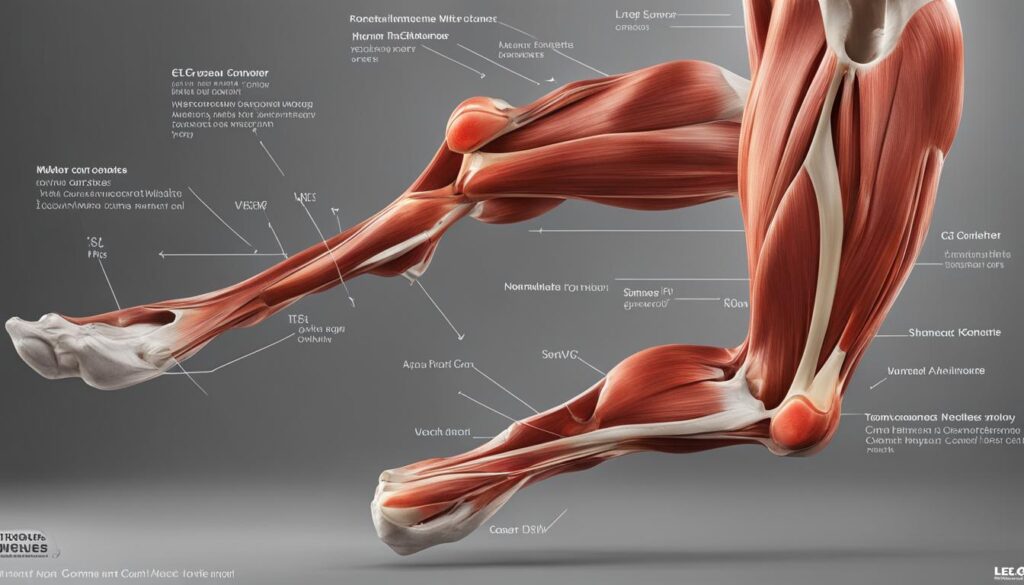For anyone who’s struggled with sudden, painful calf cramps, knowing how to prevent this unpleasant phenomenon is key. Calf cramps are involuntary contractions of the muscles in your calves. They can be quite painful and often occur unexpectedly. Fortunately, with some knowledge and proactive lifestyle modifications, preventing calf cramps is completely achievable.
Understanding the causes of calf cramps is the first step toward effective prevention. Calf cramps can occur due to a number of reasons, from dehydration to overuse of the muscle during exercise. By staying well-hydrated, stretching regularly, and maintaining a diet rich in electrolytes, you can significantly lessen your likelihood of experiencing painful calf cramps.
Remember, while calf cramps can be painful, they are generally fleeting and should not cause any long-term health concerns. In most cases, calf cramps can be well-managed at home with the right preventive strategies. However, if you regularly experience severe calf cramps, it’s best to consult with a medical professional to rule out any underlying health conditions.
Key Takeaways
- Understanding the causes of calf cramps is key to prevention.
- Poor hydration and overuse of the muscle during exercise are common causes of calf cramps.
- A proactive approach, including regular stretching and a balanced diet, can help in preventing calf cramps.
- Calf cramps are typically not a sign of any severe health condition, but regular, intense cramps may warrant a visit to a healthcare provider.
- Remember to not overexert yourself during physical activities and to hydrate adequately, especially in warm weather.
Understanding Muscle Cramps and Their Impact
Before we delve into the specifics of preventing muscle cramps in calves, it’s essential to grasp the fundamental concept of what a calf cramp is, how it’s different from other muscular pains, and its duration and intensity characteristics. It’s a prerequisite for defining the apt calf cramp prevention tips and stretches for preventing calf cramps.
What is a Calf Cramp?
A calf cramp, often referred to as a charley horse, is an unexpected tightening of the muscles in the calf that can range from a twinge to an agonizing spasm, making movement temporarily difficult and painful. It’s usually transient, lasting from a few seconds to several minutes. However, the affected area may exhibit lingering soreness after the acute pain has subsided.
Distinguishing Calf Cramps from Other Muscle Pains
Calf cramps are distinct from other muscle pains such as twitches or involuntary movements. While pain tolerance varies from person to person, calf cramps can be known to elicit a sharp, sudden ache that demands immediate attention, signifying its acute nature as opposed to chronic muscular discomfort.
Assessing the Duration and Intensity of Calf Cramps
The duration and intensity of calf cramps can greatly affect one’s quality of life. They typically last from a few seconds to 10 minutes, although severe cases can persist longer. The severity of pain can also vary, ranging from a mild stiffness to an intense ache that can disrupt sleep or routine activities.
In conclusion, understanding calf cramps and their impact is an integral step in the prevention of these involuntary muscle contractions. By incorporating appropriate hydration strategies and calf stretching exercises into our routines, we can significantly reduce the occurrence and severity of these discomforting events.
| Concept | Description |
|---|---|
| Muscle Cramps | Unexpected, involuntary muscle contractions, commonly affecting the calf muscles |
| Calf Cramps | Cramps specifically in the calf muscles, characterized by sudden, painful tightening |
| Preventing Muscle Cramps | Methods include staying hydrated, regular stretching, and maintaining a balanced diet |
Common Causes of Calf Cramps
Calf cramps, those sudden, painful muscle contractions, can be quite unsettling. It’s crucial to understand the common calf cramp causes, which often include overexertion, dehydration, and electrolyte imbalance to name a few. Below, we’ll delve into some of these triggers and explore why they have such a significant impact on muscle health.
- Overexertion: This refers to a state where the muscles have worked beyond their capacity, causing strain and subsequent pain.
- Dehydration: Lack of sufficient fluids in the body can lead to muscle stress and cramping, as water is vital for proper muscle function.
- Electrolyte Imbalance: Electrolytes help carry electrical signals from the nerves to the muscles. Imbalances can disrupt these signals, resulting in muscle contractions.

While calf cramps can be attributed to these predominant factors, there are possibly other causes linked to unique health conditions or lifestyle choices.
| Nerve compression | Chronic nerve pressure, especially on nerves in the spine, can trigger calf cramps. |
|---|---|
| Mineral Deficiency | A deficiency in crucial minerals like potassium, calcium, and magnesium can lead to muscle contractions. |
| Prolonged inactivity | Being in the same position for extended periods can cause muscle contractions. |
Risk factors can increase the possibility of experiencing calf cramps.
- Age
- Poor physical conditioning
- Heavy sweating
- Illnesses such as diabetes and liver disease
- Pregnancy
- Being overweight
It’s essential to monitor these triggers to better manage and prevent calf cramps. Remember, the first step towards relief is understanding what’s causing the discomfort.
Preventing Calf Cramps: Effective Strategies
Developing an effective strategy to prevent calf cramps involves three crucial aspects: maintaining regular hydration, ensuring proper nutrition, and customizing an exercise routine. Each component contributes to maintaining overall muscle health, potentially minimizing the risk of experiencing calf cramps.
Establishing a Hydration Routine for Muscle Health
One essential aspect of calf cramp prevention is staying hydrated. Hydration plays a pivotal role in muscle health, making it crucial to establish a regular hydration routine. Drinking water before and after physical activities can help prevent the dehydration that often leads to muscle cramps.
The Role of Proper Nutrition in Calf Cramp Prevention
Maintaining a balanced diet rich in essential minerals like potassium, calcium, and magnesium is another key strategy for preventing calf cramps. These nutrients are necessary for proper muscle function, and a deficiency in any of them can lead to muscle cramps. Including foods rich in these minerals in your daily diet can contribute significantly to calf cramp prevention.
| Mineral | Sources |
|---|---|
| Potassium | Bananas, Spinach, Potatoes, Avocados |
| Calcium | Dairy products, Leafy Green Vegetables, Almonds |
| Magnesium | Whole grains, Nuts, Seeds, Dark Chocolate |
Customizing Your Exercise Regimen to Prevent Overuse
Physical exercises, especially those tailored to the calves, are beneficial in preventing calf cramps. Regular exercise helps to improve circulation and strengthens the muscles, minimizing the chances of cramps. Key exercises for calf cramp prevention include calf stretches, leg lifts, heel drop, and walking. Schedule the exercises such that you build intensity gradually to prevent muscle overuse and consequently, calf cramps.
Nature’s Aid: Natural Remedies for Calming Calf Muscles
When faced with debilitating calf cramps, look no further than a combination of the perfect diet, hydration, and some beneficial herbal supplements. Here, we uncover how nature can lend a helping hand in soothing those aching muscles.
Herbal Supplements That May Alleviate Muscle Tension
As an alternative to over-the-counter medicine, herbs have been hailed as natural remedies for calf cramps for hundreds of years. Combining the goodness of nature with traditional medicinal knowledge, herbal supplements could provide non-invasive aid to soothe cramping muscles. Some herbs believed to aid in reducing muscle tension include Cramp Bark, Cayenne Pepper, and Chamomile. As always, it is crucial to consult a healthcare provider before starting any new supplement regime.
Essential Magnesium and Potassium-Rich Foods
Maintaining a well-balanced diet is crucial in cramp prevention, with emphasis on consumption of certain minerals. Magnesium for muscle cramps has been hailed as one of the most effective natural remedies. This wonder mineral eases muscle tension and prevents cramping. Foods high in magnesium include spinach, pumpkin seeds, and bananas.
Similarly, a deficiency of potassium can lead to muscle cramping. Introducing potassium-rich foods like kale, white beans, and potatoes in your diet can help your muscles function better and can decrease the risk of cramping.
| Magnesium-Rich Foods | Potassium-Rich Foods |
|---|---|
| Spinach | White beans |
| Pumpkin seeds | Cantaloupe |
| Bananas | Sweet potatoes |
The Impact of Hydration on Muscle Function
Lack of adequate hydration is another common cause for calf cramps. Keeping the body well-hydrated helps maintain regular muscle function by balancing out electrolytes, which prevent cramping. So, next time you find yourself dealing with recurrent cramps, reach out for a glass of water!
The Power of Stretching and Strengthening Exercises
Engaging in calf-strengthening exercises can alleviate tension in the calf muscles, contribute to muscle resilience, and potentially reduce the occurrence of calf craps. These exercises are particularly useful when incorporated in both daily routines and before bedtime to minimize the distress of night cramps.
Here are few practical and easily performed exercises that are designed to improve calf health:
- Heel lifts: Stand on your toes on a flat surface, hold for a moment, then lower your heels. Repeat.
- Jumping jacks: Adds a dynamic, cardio element that promotes overall leg strength.
- Walking lunges: These not only work the calves but also strengthen the entire leg and improve balance.
Consistency and perseverance are key to maximizing the benefits of these exercises. Remember always to warm-up before any strenuous activity, and relax and cool down afterwards.
| Exercise | Variations | Additional Benefits |
|---|---|---|
| Heel lifts | Performed with weights or on an inclined surface | Improves balance and ankle stability |
| Jumping jacks | Low impact version without the jump | Increases heart rate, improves cardiovascular health |
| Walking lunges | Performed with a twist or holding weights | Strengthens thighs and buttocks, improves core stability |
Just as strengthening is essential, stretching for calf health should also be a non-negotiable part of any calf care routine to retain muscle elasticity. A simple stretch to begin with is the standing calf stretch: stand near a wall with one foot in front of the other, front knee slightly bent, and rear knee straight. Bend forward and hold. Repeat with the other leg.
Engaging in a routine that involves calf-strengthening and stretching exercises can make a significant difference in managing and preventing cramps. By paying attention to our bodies and taking proactive steps, we can enhance our wellbeing and muscular health.
Risk Factors and How to Mitigate Them
Understanding and dealing with the risk factors for calf cramps is a key aspect of prevention. There are several common risk factors that can increase your likelihood of experiencing these painful contractions. The good news is: there is opportunity in every risk factor. Even if you tick several of the risk factor boxes, it is not too late to take action and start mitigating cramp risk factors.

- Advanced age: As we grow older, our muscle mass decreases. This can lead to frequent and painful muscle cramps.
- Inactive lifestyle: Leading a sedentary lifestyle can lead to muscle degeneration, increasing susceptibility to muscle cramps.
- Existing health conditions: Conditions like diabetes, peripheral artery disease, and kidney disease can increase the risk.
- Pregnancy: Hormonal changes during pregnancy can lead to frequent calf cramps.
A balanced approach to managing leg cramps involves lifestyle modification paired with exercise. Regular, moderate exercise can help maintain muscle tone and delay muscle atrophy associated with age. Hydration, too, plays a crucial role in reducing muscle spasms. It’s best to keep yourself well-hydrated before, during and after exercise to prevent the loss of electrolytes, which are critical for maintaining muscle function.
At times, it might be necessary to seek professional medical advice, especially if your muscle cramps are due to an underlying medical condition. The cause may need to be treated first, followed by calf cramp prevention strategies.
The journey to healthier calf muscles starts with awareness, and concerted efforts towards creating a healthier lifestyle. Remember, you have the power to alter your risk landscape and reduce the frequency of leg cramps.
Conclusion
As we reach the end of this comprehensive guide, it is important to remember that the journey towards preventing calf cramps and maintaining long-term muscle health is a progressive one. It involves incorporating certain lifestyle measures diligently and consistently, each playing a key role in preventing the occurrence of these sudden, painful muscle contractions and promoting overall well-being.
Summarizing Key Takeaways for Calf Cramp Prevention
Preventing calf cramps can be effectively achieved by staying well-hydrated, consuming a nutrient-rich diet with abundant minerals, performing regular stretching and strengthening exercises, and gaining insight into personal risk factors. These strategies not only provide immediate relief but also aim to reduce the overall occurrence of calf cramps, providing a clear path towards maintaining muscle health.
Fostering Long-Term Muscle Health
Maintaining long-term muscle health requires proactive measures aimed at keeping the muscles well-nourished, active, and flexible. This can be accomplished by regularly engaging in targeted exercises, consuming a balanced diet, and ensuring the body is adequately hydrated, especially for those leading active lifestyles. By adhering to these practices, one can cultivate an environment conducive to muscle health, thereby reducing the likelihood of experiencing calf cramps and achieving optimal physical well-being.
Source Links
- https://www.mayoclinic.org/diseases-conditions/muscle-cramp/symptoms-causes/syc-20350820
- https://www.houstonmethodist.org/blog/articles/2022/feb/muscle-cramps-8-things-that-cause-them-4-ways-to-stop-them/
- https://www.nhsinform.scot/illnesses-and-conditions/muscle-bone-and-joints/conditions/leg-cramps/





